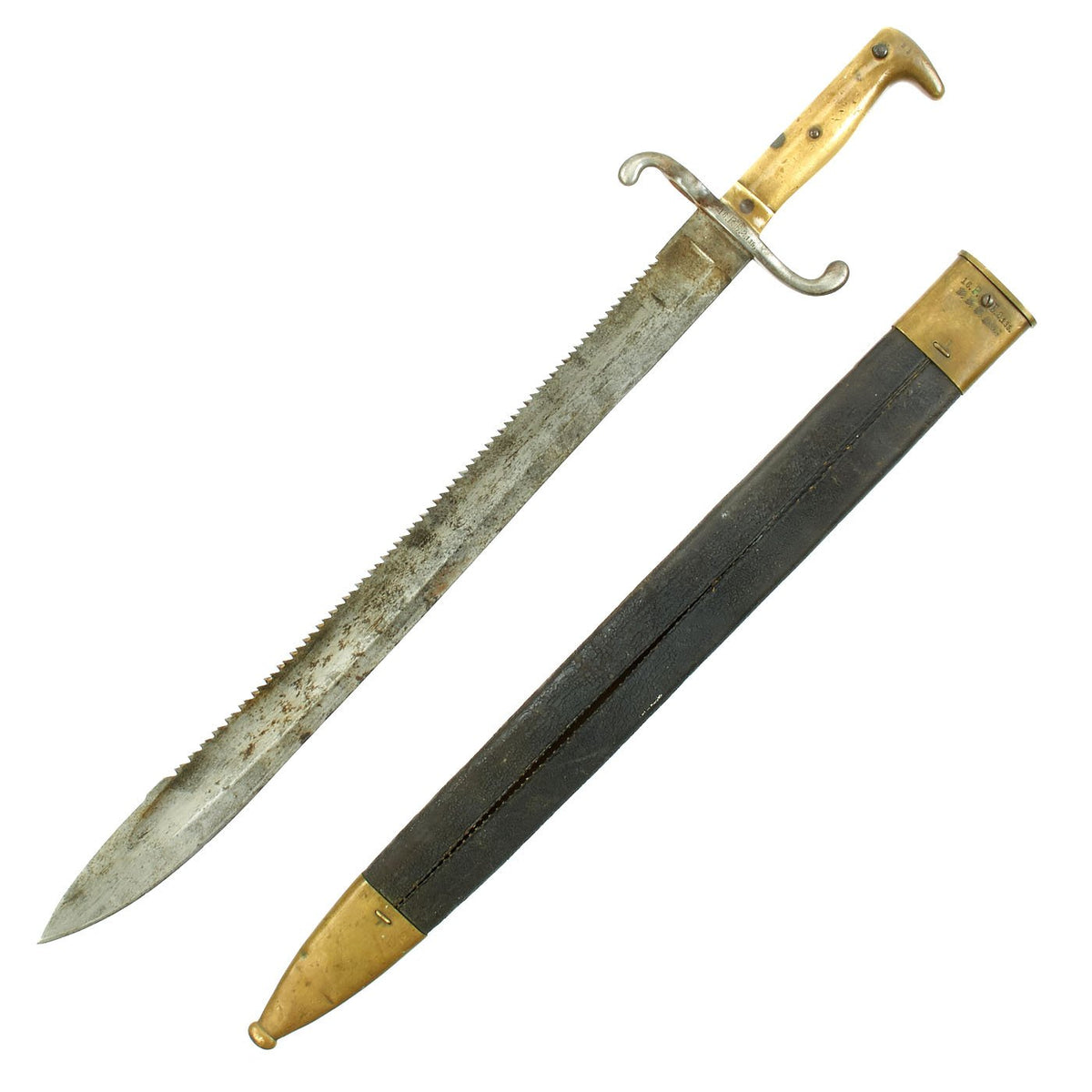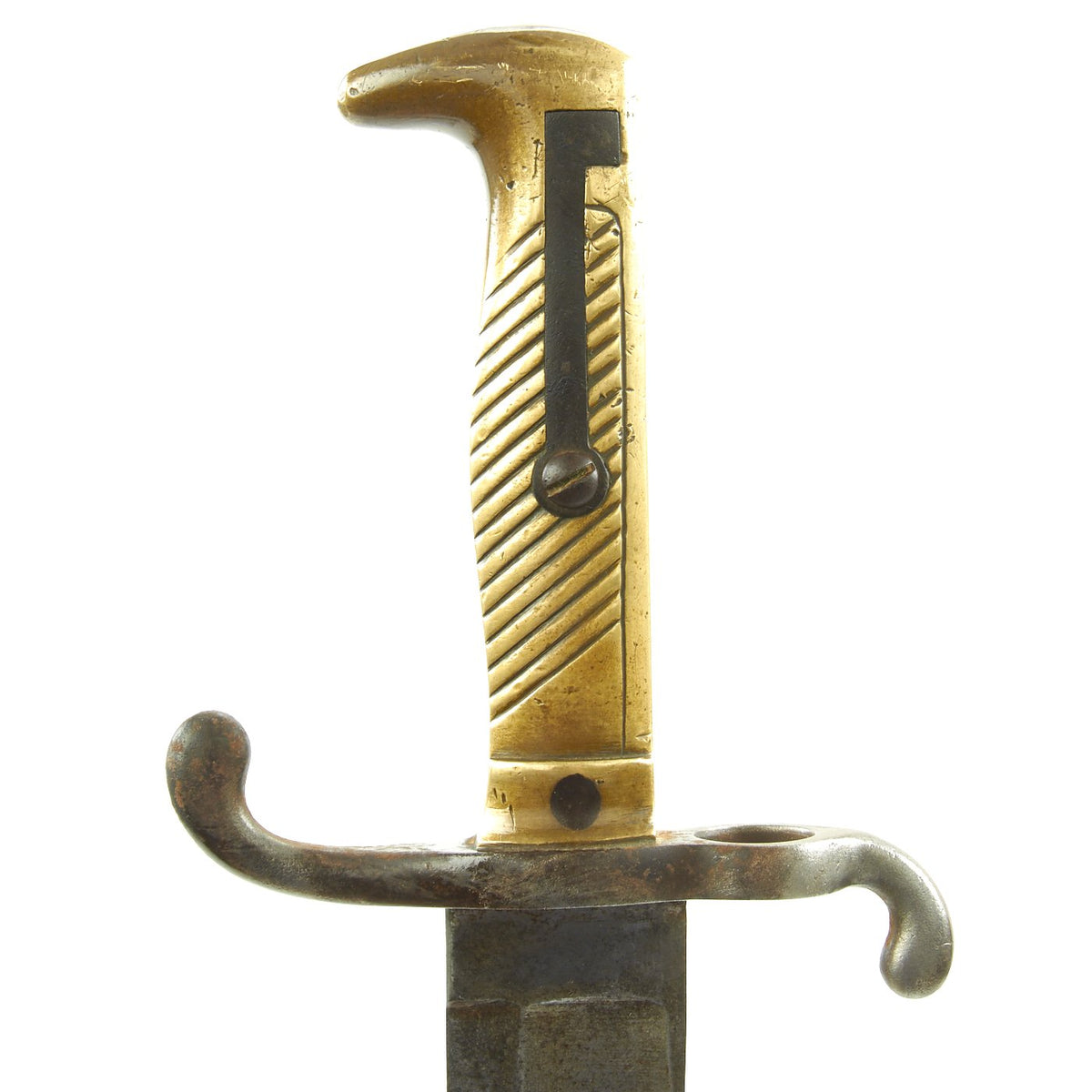Original German Mauser M1871 Faschinenmesser Pioneer Sawback Bayonet dated 1890 w/ Scabbard – Regiment Marked Original Items
$ 1.995,00 $ 498,75
Original Item: Only One Available. This is one of the most desirable Collector’s bayonets, fitted with a massive very wide 19″ SAWBACK blade, which is 1 3/4″ at its widest point. These are VERY rare, and this is the first example that we have had.
This is a very nice example of the Rare Mauser Model 1871 Faschinenmesser Pioneer Sawback Bayonet, with a brass hilt and the characteristic steel “S” cross guard. The name itself translates to “Fascine Knife”, and the design is intended both for defense an as a tool for cutting “fascines”. These are bundles of sticks and brush used to strengthen trenches, walking paths, and other types of earthen work found on the battlefield. This bayonet is the immediate predecessor of the heavy sawback pioneer swords and bayonets used in WWI.
The bayonet is in good condition, with the expected wear from age and use. The steel blade does show some use, and has areas of light oxidation and staining, as shown. The “Sawback” is still quite sharp, and it is marked on the rear of the blade with (Crown) / W/ 90, indicating acceptance in 1890 during the reign of German Emperor Wilhem II, who reigned from June 1888 – November 1918.
The reverse ricasso is maker marked:
E. & F.
HÖRSTER
SOLINGEN
E. & F. Hörster & Co is a well-known maker from Solingen, the famous “City of Blades” in Western Germany, which marketed many fine edged weapons. The firm lasted long after WWII, finally being declared insolvent in 1996.
The bayonet comes complete with its original brass mounted black leather scabbard, which is in good condition, with the expected deterioration to the leather, which has split the rear seam about halfway. There are proof marks on the drag and on the scabbard throat, which is somewhat worn from contact with the sawback of the bayonet.
Both the crossguard of the bayonet and the scabbard throat bear the same regimental marking: 16. P. E. 2. 135.. This would probably be for the 16th Pioneer Engineers Regiment, 2nd company, 135th man.
A very rare original Imperial German Pioneer Saw back bayonet, complete with its original scabbard, almost impossible to find today!
The Mauser Model 1871 adopted as the Gewehr 71 or Infanterie-Gewehr 71, or “Infantry Rifle 71” (“I.G.Mod.71” was stamped on the rifles themselves) was the first rifle model in a distinguished line designed and manufactured by Paul Mauser and Wilhelm Mauser of the Mauser company and later mass-produced at Spandau arsenal.
Paul Mauser developed his bolt-action rifle from 1867 to 1871. During 1870–71 trials with many different rifles took place, with the “M1869 Bavarian Werder” being the Mausers’ chief competitor. The Mauser was provisionally adopted on 2 December 1871, pending the development of an appropriate safety. With support from the government’s Spandau arsenal, the improvements to the safety mechanism were completed and the rifle was formally accepted on 14 February 1872 as Infantry Rifle Model 1871 by the German Empire excluding Bavaria. General issue to troops began in late 1873 and all units had been converted by the spring of 1875. The Mauser 1871 was replaced by the magazine-fed, smokeless powder using Gewehr 1888 from 1888 through 1890.
Fast Shipping with Professional Packaging
Thanks to our longstanding association with UPS FedEx DHL, and other major international carriers, we are able to provide a range of shipping options. Our warehouse staff is expertly trained and will wrap your products according to our exact and precise specifications. Prior to shipping, your goods will be thoroughly examined and securely secured. We ship to thousands clients each day across multiple countries. This shows how we're dedicated to be the largest retailer on the internet. Warehouses and distribution centres can be located throughout Europe as well as the USA.
Note: Orders with more than one item will be assigned a processing date depending on the item.
Before shipping before shipping, we'll conduct a thorough inspection of the items you have ordered. Today, the majority of orders will be delivered within 48 hours. The delivery time will be between 3-7 days.
Returns
The stock is dynamic and we cannot completely manage it because multiple stakeholders are involved, including our factory and warehouse. So the actual stock may alter at any time. It's possible that you may not receive your order once the order has been made.
Our policy is valid for a period of 30 days. If you don't receive the product within 30 days, we are not able to issue a refund or an exchange.
You can only return an item if it is unused and in the same state as the day you received it. You must have the item in its original packaging.
Related products
Uncategorized
Uncategorized
Uncategorized
Uncategorized
Uncategorized
Uncategorized
Uncategorized
Uncategorized
Band of Brothers ORIGINAL GERMAN WWII Le. F.H. 18 10.5cm ARTILLERY PIECE Original Items
Uncategorized
Uncategorized
Uncategorized
Uncategorized
Uncategorized
Uncategorized
Uncategorized
Uncategorized













































































